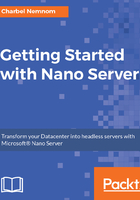
上QQ阅读APP看书,第一时间看更新
Nano Server roles and features
In this section, we will dive deeply into covering all the roles and features that are part of Nano Server in Windows Server 2016. In the table, you can see the various roles and features, and the deployment type (physical or virtual machine), including a short description that will help you to choose the right role for your environment:

Following is the description for each role:
- Compute-Package: It is the Hyper-V role which is applicable primarily for physical machines, however starting with Windows Server 2016 and Windows 10 build 10565 and later, Microsoft introduced Nested Virtualization where you can leverage this feature and host Nano Server with the compute role in a virtual machine.
- FailoverCluster-Package: It is a straightforward role. It can be used with Hyper-V or with file servers. The cluster role works either if Nano Server is hosted in a VM or on a physical machine.
- Storage-Package: It will add the necessary file server services and other storage components, such as scale-out File Servers, storage spaces direct, and storage replica.
This package is only available for the datacenter edition of Nano Server. However, the Storage and failover clustering packages contain all the storage features in this first release. If you install failover clustering you'll have Storage Spaces Direct, but you won't be able to use it in the Standard edition as it calls licensing APIs and will not run, you'll only be able to use traditional clustering.
- Containers-Package: It will add the container role to turn Nano Server into a container host. Thus, you can start deploying Windows Server containers and Hyper-V Containers on top of Nano Server. For more information about Windows Server and Hyper-V containers, see Chapter 8, Running Windows Server Containers and Hyper-V Containers on Nano Server.
- DNS-Package: It will add the DNS server on top of Nano Server. The DNS can run both on a physical and a virtual machine. However, there are some catches, which we will cover in Chapter 10, Running Other Workloads on the Nano Server.
- IIS-Package: It will add the necessary binaries to run IIS and certain features of that service. The IIS role can also run on a physical and a virtual machine. However, not all features are supported. See Chapter 10, Running Other Workloads on the Nano Server, for more information.
- Defender-Package: It is the Antivirus and the optional threat protection package that works in a VM or on a physical machine. See Chapter 10, Running Other Workloads on the Nano Server, for more information.
- OEM-Drivers-Package: It is a collection of all the inbox drivers that Microsoft shipped with Server Core 2016, it makes testing Nano Server a lot easier, of course for optimization you would absolutely want to just pick the drivers that you need for Nano Server and nothing more, but this is a convenience feature more than anything else, which contains most of the common hardware drivers that used to ship with Server Core for use on physical machines with Nano installations.
- SCVMM-Package: System Center Virtual Machine Manager (SCVMM) works on both physical and virtual machines, the VMM agent can be added into the Nano Server image to help manage, monitor, and deploy VM templates. Please note that System Center Operations Manager (SCOM) is also supported on Nano Server. However, the SCOM agent is deployed in a different way. See Chapter 5, Deploying, Managing, and Monitoring Nano Server with System Center 2016 for more information.
- DSC-Package: It works on both physical and virtual machines, the PowerShell Desired State Configuration (DSC) tool makes it possible to apply a configuration to a Nano Server, for example by using a single script you can adapt to simultaneously configure large numbers of Nano Servers.
- DCB-Package: Datacenter Bridging (DCB) provides hardware-based bandwidth allocation to a specific type of network traffic and enhances Ethernet transport reliability with the use of priority-based flow control. Hardware-based bandwidth allocation is essential if traffic bypasses the operating system and is offloaded to a converged network adapter. DCB is supported over Internet Small Computer System Interface (ISCSI), Remote Direct Memory Access (RDMA), over converged Ethernet (RoCE), or Fiber Channel over Ethernet (FCoE). Priority-based flow control is essential if the upper layer protocol, such as Fiber Channel, assumes a lossless underlying transport. It is very important to enable DCB with RDMA over Converged Ethernet. In this way, if you are using Nano Server as a storage fabric, the storage traffic will have the right priority, preventing packet loss.
- The shielded VM-Package: It is the host guardian that provides everything necessary to provision shielded virtual machines. Note that this package is only available in the datacenter edition of Nano Server.
- Secure startup-Package: It includes support for BitLocker, Trusted Platform Module (TPM), volume encryption, platform identification, cryptography providers, and other functionality related to secure startup which is a prerequisite for Shielded VMs.
- Software inventory logging-Package: It is a feature that helps server administrators to retrieve a list of the Microsoft software installed on their servers. Note that the Software Inventory Logging (SIL) package in Nano Server is agent only, not the aggregator. More information can be found here: https://technet.microsoft.com/en-us/library/dn268301(v=ws.11).aspx.
There are some additional roles and features that don't come in a package, but are certainly important, such as MPIO, NIC teaming, and using an SSH provider.